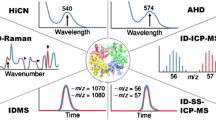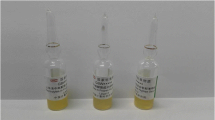Abstract
The widespread occurrence of heparin contaminated with oversulfated chrondroitin sulfate (OSCS) in 2008 initiated a comprehensive revision process of the Pharmacopoeial heparin monographs and stimulated research in analytical techniques for the quality control of heparin. Here, a set of 177 heparin samples from the market in 2008 as well as pure heparin sodium spiked with defined amounts of OSCS and DS were used to evaluate established and novel methods for the quality control of heparin. Besides 1H nuclear magnetic resonance spectroscopy (NMR), the assessment included two further spectroscopic methods, i.e., attenuated total reflection-infrared spectroscopy (ATR-IR) and Raman spectroscopy, three coagulation assays, i.e., activated partial thromboplastin time (aPTT) performed with both sheep and human plasma and the prothrombin time (PT), and finally two novel purity assays, each consisting of an incubation step with heparinase I followed by either a fluorescence measurement (Inc-PolyH-assay) or by a chromogenic aXa-assay (Inc-aXa-assay). NMR was shown to allow not only sensitive detection, but also quantification of OSCS by using the peak-height method and a response factor determined by calibration. Chemometric evaluation of the NMR, ATR-IR, and Raman spectra by statistical classification techniques turned out to be best with NMR spectra concerning the detection of OSCS. The validity of the aPTT, the current EP assay, could be considerably improved by replacing the sheep plasma by human plasma. In this way, most of the contaminated heparin samples did not meet the novel potency limit of 180 IU/mg. However, also more than 50% of the uncontaminated samples had <180 IU/MG. In contrast to the aPTT, the PT specifically detects OSCS and other heparin mimetics (LOD 3%). About ten times more sensitive are both the Inc-PolyH-assay and the Inc-aXa-assay, two rapid and simple quantification assays for heparin mimetics. The determined OSCS contents of the heparin samples excellently correlated with those calculated from the NMR spectra. In conclusion, NMR proved to be the current spectroscopic method of choice. The two two-step-assays represent options to supplement NMR, especially as tests for the initial screening, since they detect any heparin mimetic without requiring special expertise for interpretation of the results.







Similar content being viewed by others
References
FDA, U.S. Food and Drug Administration (2009) Information on Adverse Event Reports and Heparin. http://www.fda.gov/Drugs/DrugSafety/PostmarketDrugSafetyInformationforPatientsandProviders/ucm112669.htm. Accessed 11 June 2010
Royce K FDA failures contribute to spread of contaminated drugs (2008) Worldfocus 17.12.2008 http://worldfocus.org/blog/2008/12/17/fda-failures-contribute-to-spread-of-contaminated-drugs/3287/. Accessed 11 Jun 2010
Guerrini M, Beccati D, Shriver Z, Naggi A, Viswanathan K, Bisio A, Capila I, Lansing JC, Gulieri S, Fraser B, Al-Hakim A, Gunay NS, Zhang Z, Robinson L, Buhse L, Nasr M, Woodchock J, Langer R, Venkataraman G, Linhardt RJ, Casu B, Torri G, Sasisekharan R (2008) Oversulfated chondroitin sulfate is a contaminant in heparin associated with adverse clinical events. Nat Biotechnol 26:669–675
Liverani L, Mascellani G, Spelta F (2009) Heparins: process-related physico-chemical and compositional characteristics, fingerprints and impurities. Thromb Haemost 102:846–853
Mulloy B, Gray E, Barrowcliffe TW (2000) Characterisation of unfractionated heparin: comparison of materials from the last 50 years. Thromb Haemost 84:1052–1056
McEwen I, Mulloy B, Hellwig E, Kozerski L, Beyer T, Holzgrabe U, Rodomonte A, Wanko R, Spieser JM (2008) Determination of oversulphated chondroitin sulphate and dermatan sulphate in unfractionated heparin by 1H-NMR. Collaborative study for quantification and analytical determination of LoD. Pharmeur Bio 1:31–39
Beyer T, Diehl B, Randel G, Humpfer E, Schäfer H, Spraul M, Schollmayer C, Holzgrabe U (2008) Quality assessment of unfractionated heparin using 1H nuclear magnetic resonance spectroscopy. J Pharm Biomed Anal 48:13–19
Bigler P, Brenneisen R (2009) Improved impurity fingerprinting of heparin by high resolution 1H NMR spectroscopy. J Pharm Biomed Anal 49:1060–1064
Guerrini M, Shriver Z, Bisio A, Naggi A, Casu B, Sasisekharan R (2009) The tainted heparin story: an update. Thromb Haemost 102:907–911
Guerrini M, Shriver Z, Naggi A, Casu B, Linhardt RJ, Torri G, Sasisekharan R (2010) Reply to oversulfated chondroitin sulfate is not the sole contaminant in heparin. Nat Biotechnol 28:207–211
McEwen I, Rundlöf T, Ek M, Hakkarainen B, Carlin G, Arvidsson T (2009) Effect of Ca2+ on the 1H NMR chemical shift of the methyl signal of oversulphated chondroitin sulphate, a contaminant in heparin. J Pharm Biomed Anal 49:816–819
McEwen I (2010) Broadening of 1H-NMR signals in the spectra of heparin and OSCS by paramagnetic transition metal ions. The use of EDTA to sharpen the signals. J Pharm Biomed Anal 51:733–735
Zhang Z, Boyangzi L, Suwan J, Zhang F, Wang Z, Liu H, Mulloy B, Linhardt RJ (2009) Analysis of pharmaceutical heparins and potential contaminants using 1H-NMR and PAGE. J Pharm Sci 98:4017–4026
Heparin sodium, monograph Stage 2 (2009) US Pharmacopoeia, Rockville http://www.usp.org/USPNF/notices/heparinRB20090828.html
Heparin sodium, monograph 0333 (2010) European Pharmacopoeia, Council of Europe, Strasbourg, PA/PH/Exp. 6/T (09) 42 PUB. http://www.edqm.eu/en/What-new-525.html
Somsen GW, Tak YH, Toraño JS, Jongen PMJM, de Jong GJ (2009) Determination of oversulfated chondroitin sulfate and dermatan sulfate impurities in heparin by capillary electrophoresis. J Chromatogr A 1216:4107–4112
Volpi N, Maccari F, Linhardt RH (2009) Quantitative capillary electrophoresis determination of oversulfated chondroitin sulfate as a contaminant in heparin preparations. Anal Biochem 388:140–145
Wieglos T, Havel K, Ivanova N, Weinberger R (2009) Determination of impurities in heparin by capillary electrophoresis using high molarity phosphate buffers. J Pharm Biomed Anal 49:319–326
Trehy ML, Reepmeyer JC, Kolinski RE, Westenberger BJ, Buhse LF (2009) Analysis of heparin sodium by SAX/HPLC for contaminants and impurities. J Pharm Biomed Anal 49:670–673
Domanig R, Jöbstl W, Gruber S, Freudemann T (2009) One-dimensional cellulose acetate plate electrophoresis—a feasible method for analysis of dermatan sulfate and other glycosaminoglycan impurities in pharacetuical heparin. J Pharm Biomed Anal 49:151–155
Alban S, Lühn S (2008) Prothrombin time for detection of contaminated heparins. N Engl J Med 359:2732–2734
Norwig J, Beyer T, Brinz D, Holzgrabe U, Diller M, Manns D (2009) Prediction of the oversulphated chondroitin sulphate contamination of unfractionated heparin by ATR-IR spectroscopy. Pharmeur Sci Notes 2009:17–24
Bairstow S, McKee J, Nordhaus M, Johnson R (2009) Identification of a simple and sensitive microplate method for the detection of oversulfated chondroitin sulfate in heparin productions. Anal Biochem 388:317–321
Guerrini M, Zhang Z, Shriver Z, Naggi A, Masuko S, Langer R, Casu B, Linhardt RJ, Torri G, Sasisekharan R (2009) Orthogonal analytical approaches to detect potential contaminants in heparin. Proc Natl Acad Sci 106:16956–16961
Sitkowski J, Bednarek E, Bocian W, Kozerski L (2008) Assessment of oversulfated chondroitin sulfate in low molecular weight and unfractioned heparins diffusion ordered nuclear magnetic resonance spectroscopy method. J Med Chem 51:7663–76665
Hashii N, Kawasaki N, Itoh S, Qin Y, Fujita N, Hattori T, Miyata K, Bando A, Sekimoto Y, Hama T, Kashimura M, Tatsumi M, Mabuchi K, Namekawa H, Sakai T, Hirose M, Bobashi S, Shimahasi H, Koyama S, Herr SO, Kawai K, Yoden H, Yamaguchi T (2010) Heparin identification test and purity test for OSCS in heparin sodium and heparin calcium by weak anion-exchange high-performance liquid chromatography. Biologicals. doi:10.1016/j.biologicals.2010.04.002
Pan J, Qian Y, Zhou X, Pazandak A, Frazier SB, Weiser P, Lu H, Zhang L (2010) Oversulfated chondroitin sulfate is not the sole contaminant in heparin. Nat Biotechnol 28:203–207
Lühn S, Schiemann S, Alban S (2010) Simple fluorescence assay for quantification of OSCS in heparin. Anal Bioanal Chem. Online First (16.06.10): doi:10.1007/s00216-010-3867-5
Neville GA, Mori F, Holme KR, Perlin AS (1989) Monitoring the purity of pharmaceutical heparin preparations by high-field 1H-NMR magnetic resonance spectroscopy. J Pharm Sci 78:101–104
Linhardt RJ, Gunay NS (1999) Production and chemical processing of low molecular weight heparins. Semin Thromb Hemost 25:5–16
Beyer T, Matz M, Brinz D, Rädler O, Wolf B, Norwig J, Baumann K, Alban S, Holzgrabe U (2010) Composition of OSCS-contaminated heparin occuring in 2008 in Batches on the German market. Eur J Pharm Sci 40:297–304
Sun W, Bandmann H, Schrader T (2007) Chemistry 13:7701–7707
Infrared Absorption Spectrophotometry, general method 2.2.24 (2008), European Pharmacopoeia, Council of Europe, Strasbourg
Schmid U, Rösch P, Krause M, Harz M, Popp J, Baumann K (2009) Gaussian mixture discriminant analysis for the single-cell differentiation of bacteria using micro-Raman spectroscopy. Chemom Intell Lab Syst 96:159–171
MacLachlan GJ (1991) Discriminant analysis and pattern recognition. Wiley, New York
Jolliffe IT (2002) Principal component analysis, 2nd edn. Springer, New York
Efron B, Tibshirani R (1993) An introduction to the bootstrap. Chapman & Hall/CRC, Boca Raton
Wehrens R, Putter H, Buydens LMC (2000) The bootstrap. A tutorial. Chemom Intell Lab Syst 54:35–52
Breiman L (1996) Out-of-bag estimation, Technical Report. Department of Statistics, University of California, USA
Wolpert DH, Mcready WG (1999) An efficient method to estimate bagging’s generalization error. Mach Learn 35:41–55
Breiman L (2001) Random forests. Mach Learn 45:5–32
Svetnik V, Liaw A, Tong C, Culberson JC, Sheridan RP, Feuston BP (2003) Random forest: a classification and regression tool for compound classification and QSAR modeling. J Chem Inf Comput Sci 43:1947–1958
Holme KR, Perlin A (1989) Nuclear magnetic resonance spectra of heparin in admixture with dermatan sulfate and other glycosaminoglycans. 2-D spectra of the chondroitin sulfates. Carbohydr Res 186:301–312
Keire DA, Mans DJ, Ye H, Kolinski RE, Buhse LF (2010) Assay of possible economically motivated additives or native impurities levels in heparin by 1H NMR, SAX-HPLC, and anticoagulation time approaches. J Pharm Biomed Anal 52:656–664
Rabenstein DL, Keire DA (1991) Quantitative chemical analysis by NMR. In: Popov AI, Hallenga K (eds) Modern NMR techniques and their application in chemistry. Marcel Dekker, New York, pp 323–369
Chandola V, Banerjee A, Kumar V (2009) Anomaly detection: a survey. ACM Comput Surv 41, Article 15
Rudd TR, Skidmore MA, Guimond SE, Cosentino C, Torri G, Fernig DG, Lauder RM, Guerrini M, Yates EA (2009) Glycosaminoglycan origin and structure revealed by multivariate analysis of NMR and CD spectra. Glycobiology 19:52–67
Li B, Suwan J, Martin JG, Zhang F, Zhang Z, Hoppensteadt D, Clark M, Fareed J, Linhardt RJ (2009) Oversulfated chondroitin sulfate interaction with heparin-binding proteins: new insights into adverse reactions from contaminated heparins. Biochem Pharmacol 78:292–300
Schiemann S, Lühn S, Alban S (2010) A novel method for the simultaneous detection of various contaminants in heparins. Hamostaseologie 30:A111
Greinacher A, Warkentin TE (2008) Contaminated heparin. N Engl J Med 359:1291–1293
Lühn S, Schrader T, Sun W, Alban S (2010) Development and evaluation of a fluorescence microplate assay for quantification of heparins and other sulfated carbohydrates. J Pharm Biomed Anal 52:1–8
Alban S, Lühn S (2009) Prothrombin time as a simple screening method to identify heparins contaminated with OSCS and similar compounds. J Thromb Haemost 7(Suppl 2):PP-TH-193
Acknowledgment
Thanks are due to the Federal Institute for Drugs and Medical Devices for providing financial support to UH.
Author information
Authors and Affiliations
Corresponding author
Additional information
Published in the special issue Heparin Characterization with Guest Editor Cynthia K. Larive.
An erratum to this article can be found at http://dx.doi.org/10.1007/s00216-010-4317-0
Electronic Supplementary Material
Below is the link to the electronic supplementary material.
ESM 1
(PDF 571 kb)
Rights and permissions
About this article
Cite this article
Alban, S., Lühn, S., Schiemann, S. et al. Comparison of established and novel purity tests for the quality control of heparin by means of a set of 177 heparin samples. Anal Bioanal Chem 399, 605–620 (2011). https://doi.org/10.1007/s00216-010-4169-7
Received:
Revised:
Accepted:
Published:
Issue Date:
DOI: https://doi.org/10.1007/s00216-010-4169-7




